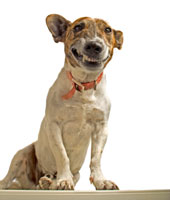How Dogs Smile
 Philosophy is the talk on a cereal box
Philosophy is the talk on a cereal boxReligion is the smile on a dog
-Edie Brickell & the New Bohemians
Your happy, wagging dog plants his butt and looks up at you, panting expectantly. The lips draw back, teeth exposed, and the corners of the mouth turn up ever so slightly. Is your dog actually smiling?
In the canine world, the smile is an appeasement gesture that indicates submission or nervousness. It might be better described as a “grin” or “grimace” that means “I’m not a threat. I won’t challenge you. I like you.” It is often accompanied by other submissive body language, such as stooped posture, lowered tail, and averted gaze. A dog might grin at a human in such way as a deferential greeting that we interpret as a smile.
But be careful. A dog with retracted lips and bared teeth may not be friendly. This is especially true if accompanied by erect body and tail posture and a growl. Many people have gotten bitten by misinterpreting this classic show of aggression as a friendly smile. As with all canine communication, it’s important to take all the body cues into consideration.
So what about the classic happy-dog smile, with full body wiggle, tongue lolling? A behavioral model suggests that dogs learn to mirror our expressions because we unwittingly teach them to do so. We actually train them to “smile” at us by rewarding them with snuggles or a treat. Steven Budiansky, author of The Truth About Dogs, proposed that dogs are intuitive brown-nosers that have adopted a survival-of-the-friendliest strategy. By learning our language, they have earned access to our homes, our food, and our hearts.
The smile of the dog: Heartfelt gesture or artful ploy? That may give you something to smile about.
You May Also Like These Articles:
Dogs Make the Best Matchmakers
Why Do Dogs Tilt Their Heads When You Talk?
The Yellow Dog Project: What Does the Yellow Ribbon Mean?
Disclaimer: This website is not intended to replace professional consultation, diagnosis, or treatment by a licensed veterinarian. If you require any veterinary related advice, contact your veterinarian promptly. Information at DogHealth.com is exclusively of a general reference nature. Do not disregard veterinary advice or delay treatment as a result of accessing information at this site. Just Answer is an external service not affiliated with DogHealth.com.
Notice: Ask-a-Vet is an affiliated service for those who wish to speak with a veterinary professional about their pet's specific condition. Initially, a bot will ask questions to determine the general nature of your concern. Then, you will be transferred to a human. There is a charge for the service if you choose to connect to a veterinarian. Ask-a-Vet is not manned by the staff or owners of DogHealth.com, and the advice given should not delay or replace a visit to your veterinarian.


